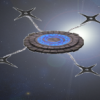-Jitter and packet loss causing character movement to not look fluent
-High latency causing situations similar to the infamous shooting-around-the-corner problem
-Connection loss causing players to be disconnected
-Latency spikes / short periods of no packets coming through
In some sense, "welcome to the internet." :-(
For the last week, I've had extreme connection problems between my and the Guild Wars 2 servers, with frequent disconnects and client crashes. This is a major title, with pretty reasonably skilled operators, using controlled servers, connecting from a major metro area (Silicon Valley.) Once you introduce user hosts (many of them, for peer-to-peer,) then the problem just gets worse.
The fact that you think it's a problem that high latency causes the shot-around-the-corner problem means that you are thinking about the design in terms of local LAN multiplayer. Unfortunately, the internet is nothing like that. You may, very well, not be able to achieve what you want to achieve through technical means. You seem to be looking for "some way to make the network less terrible," rather than looking for "some way to make the game and game design more robust in the face of a terrible network." I totally understand the urge, but I'm not optimistic you will make great strides in that direction.
If I had to look in that direction, I would attempt to set the QoS field of the packets, and perhaps switch to a UDP port that's frequently used for other real-time needs (such as IP telephony or IPTV,) and see if some networks pay attention to these things. Chances are, most users would be unaffected, and perhaps some home gateways would barf on the QoS bits.
The real solution to the problem of the internet is more likely to include some combination of:
- visualization of detected quality and problems to users in real time
- education of users for what they can do, and what they should expect
- change the game design to be more tolerant of latency (yes, this makes some particular game designs impossible!)
- change the technical implementation to be more tolerant of changing network conditions (adaptive de-jitter buffer, smoothing in position display, tolerant of temporary black holes, etc)






